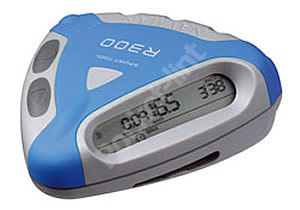For runners, stats are everything, how fast am I going? How far have I run? How long is there left? Are questions we all ask ourselves as we pound that pavement or country path. While Garmin offer the Forerunner, a beast of a unit, Navman has opted for a downsized, consumer-friendly unit. But is it up to the task. Deciding that the only real way to test this was by doing a marathon, we did just that. We’re dedicated like that here at Pocket-Lint.
Our quick take
Gripes, well the timing feature could be improved. The GPS receiver can take up to 80 seconds to pick up the requisite number for satellites to get the R300 working and no timing can start before the GPS signal has be acquired. Once a signal has been received, and the R300 detects you are moving, the session timer starts, this can mean that as you walk to the start line, the clock starts timing or, if you wait until the last minute to turn the R300 on, the gun has been fired and you have started to move before the device has come ‘online' and the timer started. Loss of GPS signal mid-run can also be as problem as was discovered in our Paris Marathon where 2 Km was run through a road tunnel. This resulted in a loss of a sustained signal, and resulted in a discrepancy of 10 minutes between the R300's timing and the official timing.
Overall the R300 is a better tool for the open cross-country style runner, who wants to know more about the distance and duration of the run, rather than hyper-accurate sprint timings. As the display is small, looking at the R300 while moving is difficult and some of the display icons could be easily mistaken for one other. The instruction manual is annoyingly overly complicated and you can learn more about how to use, and set up the R300, from the ‘quick start' card than from the more comprehensive version. The price is excellent though, as is the compact size and design, making it a useful training aid for any keen runner.

Navman R300 sport.tool - 3.5 / 5
| FOR | AGAINST |
|---|---|
|
|
The blue-shelled R300 is the running model of the Sport.Tool’s range, released by Navman and displays options and data applications geared towards the needs of the distance runners.
Navman has opted to choose an arm-mounted device rather than a wrist-based watch for the R300 and we found that best results are achieved by having it directly against the skin, to prevent movement, although it will stay in place over a jacket - it’s just a case of pulling the strap tighter. The triangular body is robustly built and light enough not to cause any discomfort over extended durations of use. Power comes from a single AA battery and the manufacturers estimate up to 16 hours’ use before it needs changing. The battery door is secured with screw-thread bolt, with a D-ring head, to maintain the waterproof seal that closes the compartment off from both the elements and perspiration from the runner’s skin.
The R300 relies on a GPS signal to locate the device and then track the runner’s distance, pace and speed overland. A GPS signal must be received for the device to work and close attention must be paid to running through urban areas where buildings or underpasses can obscure the signal for durations of time, leading to inaccurate timings. The R300’s on-board date and time are automatically updated via the same GPS signal, although there is an offset option to add in time difference, to get the correct local time. Personal information can also be entered into the device, so calories burned can be calculated while you run.
The relatively small LCD screen, which faces the runner when they gaze down lacks a backlight feature so can be quite hard to read when on the move. We personally would have opted for a bright LED-styled device that is clear no matter what the weather or light conditions are.
The displays show session and lap time (holding data on up to 50 laps, per session), total distance run and current altitude, your pace and maximum and minimum ‘zone’ alarms, which can be set to sounds if you are either running too fast or too slowly.
All operations are controlled by one of two mounded buttons on the R300’s top surface. These buttons are either pressed independently or simultaneously to change modes, displays, or to configure set-up menus. With the variety of options, this initially leads to the going round in circles a few times, not greatly aided by the instruction manual that could be made clearer, but overall operations are fairly easy to grasp.
To recap
A useful monitoring tool. Some of the features could do with being more manual, such as the time keeping, although in general all the information given is useful
